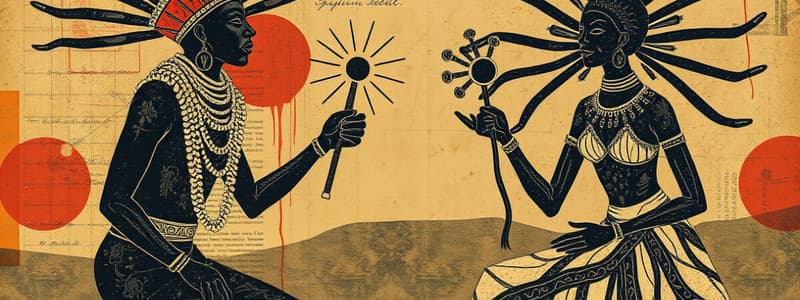Podcast
Questions and Answers
What significance do the bulging eyes of Elegba and his wife hold in Yoruba culture?
What significance do the bulging eyes of Elegba and his wife hold in Yoruba culture?
- They embody the power-to-make-things-happen. (correct)
- They indicate a connection to the spirit world.
- They represent wisdom and old age.
- They symbolize the duality of life and death.
Which element is commonly included in representations of Eshu to signify his powers?
Which element is commonly included in representations of Eshu to signify his powers?
- A carved wooden staff
- A round fan
- A beaded crown
- A calabash containing power (correct)
What does the rising knifelike element from Elegba's head signify?
What does the rising knifelike element from Elegba's head signify?
- The completion of his transformation.
- The beginning of the display of his powers. (correct)
- A warning to others.
- The end of his powers.
What artistic technique is evident in the transformation of knives into serpent heads in Eshu's representation?
What artistic technique is evident in the transformation of knives into serpent heads in Eshu's representation?
How are the Yoruba riverain goddesses, like Yemoja, typically represented artistically?
How are the Yoruba riverain goddesses, like Yemoja, typically represented artistically?
What is the significance of the crimson parrot feather in Yoruba art and Eshu-Elegbara representation?
What is the significance of the crimson parrot feather in Yoruba art and Eshu-Elegbara representation?
In a cultural context, how do the Cubans uniquely honor Eshu?
In a cultural context, how do the Cubans uniquely honor Eshu?
What type of medium is considered the oldest for representing Eshu?
What type of medium is considered the oldest for representing Eshu?
What was a primary function of the images of Eshu brought to New York City after World War II?
What was a primary function of the images of Eshu brought to New York City after World War II?
What aspect of Eshu would likely be lost if one does not understand its cultural significance?
What aspect of Eshu would likely be lost if one does not understand its cultural significance?
Flashcards are hidden until you start studying
Study Notes
Eshu Elegba
- Eshu Elegba figures exist in hundreds across the United States, primarily made from clay or concrete.
- Villagers from Egbado, Nigeria, interpret these images as representations of both Eshu and his wife, highlighting gender duality.
- Eshu symbolizes life and individuality, embodying both male and female principles.
- Characterized by bulging eyes, these figures represent Eshu’s divine power granted by God, which embodies potential for miracles.
- The male figure typically holds a weapon (club or sword) alongside a calabash, while the female figure offers a nurturing gesture.
- Knife-like elements emerging from Eshu's head indicate the start of his miraculous powers; he is often referred to as Eshu Odara, "the Wonder-Worker."
- Eshu's influence extends into Afro-Brazilian culture, particularly in Bahia and Havana, and reappears in Hispanic communities in New York City and Miami.
Yemoja (Yemaya)
- Represented through round fans (abebe), crowned ornaments (ade), and containers (awota) filled with sacred water and earth elements.
- Yemoja symbolizes river goddess attributes, connecting to the Yoruba tradition, indicating reverence for water and fertility.
- Artistic strategies incorporate the use of fans to embody the essence of river spirits, highlighting their mystical qualities.
Cultural Significance and Practices
- In Cubans’ practices, Eshu represents change, with rituals involving the pouring of cool water at crossroads, performed discreetly.
- Brazilians honor Eshu at urban intersections and under skyscrapers, using local spaces for spiritual connection.
- Lateritic earth serves as the oldest medium for representing Eshu, with wooden sculptures reflecting cultural diversity in Nigeria and Benin.
Artistic Representations
- Two main categories of wood sculptures depict supplicant figures or matched male-female pairs, often adorned with cowrie shells.
- After World War II, Caribbean traditions of Eshu worship migrated to urban centers like New York and Miami, integrating into local culture.
River Goddesses and Their Attributes
- Yoruba river goddesses are often depicted as powerful women, associated with themes of vengeance and protection, skilled in mystic arts.
- Round fans, an emblem of Yemoja, signify both authority and mysticism, forming part of a sacred visual language in Yoruba art.
Oshun's Mythology
- Oshun, once married to Ifa, is known for her passionate relationship with a thunder god, showcasing attributes of fertility and wealth.
- Upon her death, her treasures were believed to submerge in the river, solidifying her connection to water and prosperity.
Studying That Suits You
Use AI to generate personalized quizzes and flashcards to suit your learning preferences.
